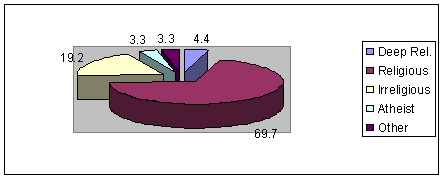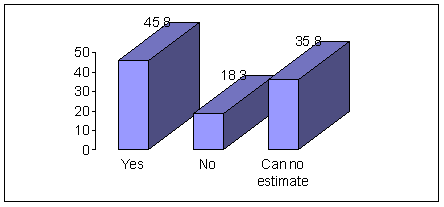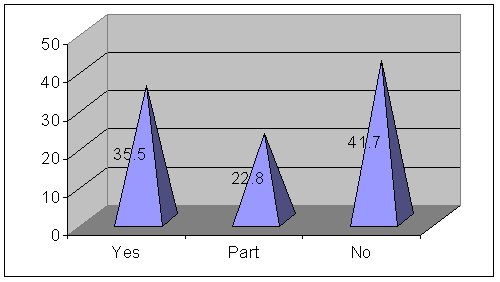
Maria Serafimova
In the times of totalitarian rule in the Bulgarian society, the term religion was excluded from the communist vocabulary. At the same time the religious metamorphosis of communism transformed it into a closed code of meanings, whose interpretation is solely in the hands of a clerical group, that imposed its' power. In relation with religion, double standards were established: the communist constitution proclaims freedom of creeds, but at the same time aggressive atheism is practically uncontrolled and is systematically encouraged in the name of the new, socialistic conscience.
The abatement of religious sentiment is a result of deep penetration of secular elements in the meaning of many of the Christian ceremonies. The atheism as an extreme form of secular monopolism had significantly influenced the attitude that the Bulgarian society has towards religion. The influence and social prestige of religious institutions was diminished. The contemporary Bulgarian society, being in a transition from totalitarism to democracy, had been formed by atheism. As a state ideology the atheism in Bulgaria openly proclaimed the necessary eradication of religion.
After the fall of totalitarian society, the Orthodox Church and other churches in Bulgaria experienced a revival. Church rituals such as baptisms and church weddings attracted renewed interest, and traditional church holidays were observed more widely. Christmas 1990, the first Christmas under the new regime, was widely celebrated and greatly promoted in the mass media.
The old paternalistic structures had been destroyed on an individual and also on a collective level. When those, who had revolted against these values, finally annihilate them, a gigantic necessity for a new authoritarian submission arose. People search for substitutes now by participating in mass activities and seeking collective euphoria. The separate person tries to create bonds with someone or something else, in order to re-establish security and start feeling a part of the whole.
Tradition typically recuires a collective legitimiting of a memory, of a past that may or may not have really existed. Tradition and imagination create and constitute imagined dynamics that can embrace any object. Each human community, each human formation can be defined with reference to these two ideal poles. If the traditional and the modern are two ideal-typical poles, the present day Bulgarian society is situate somewere between the two of them. In all cases it is a mixture combining the pole of traditionalism, defined by continuity with the past, and the pole of modernity, defined by change, novelty and innovation. There can be no substantive definition of religion. If the notion of religion is desubstantialized, what remains of it is, as far as possible a way of believing that is compatible with the idea of tradition. Its contents are not defined a priori and they refer to the way of validating a given collective memory.
The reversion to traditional system of religious ceremonies and holidays is characteristic for the Bulgarian society. This fulfills people's need for collective co-experience, spiritual and social integration.
The whole of the religious answers constitutes the sacred universe of traditional societies, but it could be included in the creation of a modern sacred. In a condition, that "sacred" doesn't mean only "religious", religion could help to legitimate the purposes and actions of the society, to strengthen the determination of the people.
A lot of instances can be adduced, of the reviving of traditions, which in new conditions have a purely cultural meaning and function as forms of solidarity. For example, the religious ritual is performed often when a new building, a school or an office are being consecrated. By its’ origins and meaning this is a religious ritual, but it assumes a worldly function. In fact it symbolizes a kind of social solidarity and a collective sentiment. Religion unites the individuals into a community and prescribes the fundamental rules of their every-day lives.
Religious practices and even the most intimate religious acts have a social meaning and a social context. Religious activity helps in becoming conscious of one’s community, to express symbolically the social order and to gain an objective sensation about society.
Rituals and ceremonies allow collective sentiment to be experienced and a sense of social unity to be expressed. Thus, religion stands in support of social solidarity. When people gather on solemn occasions – reverent, they achieve a deep sense of themselves and of the legitimacy of their social organization.
It presents no problem for a well established, stable social world to go from the past, through the present and towards the future, but what if the crises are consecutive and never ending. A necessity of security and support, a need of firm grounds for the worldly and social universe of the people, appears in that case.
Is it possible for a person to isolate himself from the surroundings, the people and the society, trying to stay away from the hardships, that go along with everyday life. Even as a side-observer, one always experiences the event in a certain degree. A part of him is left open to the world and is revolting because deep inside he still believes in human charity and humanity.
Faith is the foundation of every religion, and from an internal point of view it uncovers itself on the basis of its’ natural essence and boundaries, beyond which is everything that is devoid of every religion sense. Religion is the source for supreme identity of the human behavior, it corresponds to all the fundamental human necessities. The religion meanings are, in their turn, incarnated into religions symbols, such as the cross, the candles, the icons etc. In order to reach those meanings, the religious life has to be institutionalized by the religion. This is the process of making it an institution.
The Southwest University "Neofit Rilsky" can be regarded as a contact zone, where cultural, political, historical, religious events, destinies and interests interweave. In the Southwest region different types of identities met - bulgarians, gypsies, pomaks, turks, macedonians etc. Therefor it is important to create a proffesional insight in the students, sense of the ethnic variety, skills to work and communicate in ethnically differentiated environment and high degree of tolerance.
In a place like this, one can easily see the existence of different phenomena and processes, related with the diverse aspects of traditional and modern religiosity in the Bulgarian society.
The purposes of this presentation is closely related with the mission of the university itself because the region where is located is one of the best examples for ethnic variety which is characteristic of the Republic of Bulgaria as a whole. Essential part is dedicated to analyses from sociological surveys. They can be traced through qualitative methods, rather than quantitative ones.
Religious and ethnical identity of the students
in the SW University “Neofit Rilsky”
In 2004/2005, a team of specialists (Maria Serafimova, Tania Nedeltcheva, Vladimir Dulov) from the Department of Sociology in the Faculty of Law and History of the South West University in Blagoevgd (Bulgaria)) conducted a sociological survey which main subject was: Religious and ethnical identity of the students in the SW University “Neofit Rilsky”. The team was formed by students and professors from the department, which gave additional possibilities for obtaining information and conducting observation with participation. The conducted empirical sociological survey is based on a representative extraction, including the 863 students from the SW University “Neofit Rilsky”.
The analysis of the results shows that the Christian Orthodox Creed dominates – 83, 2 % of the participants. The Catholic creed is second with 3,3 % and Sunni Islam is third with 2,8 %. The Protestant version of Christianity is represented by 1,4 % of the participants in the survey. 1,7 % define themselves as representatives of creeds, different of Christianity, Judaism and Islam. All this means that representatives of creeds, other that Orthodox Christianity are in fact in a state of isolation from their religious environment and are dependent in a great degree on the tolerance of the Orthodox Christians. At the same time they affirm, that good relation between the different religious communities are possible, which implies the positive conclusion that the majority of Christian students in the SW University are tolerant towards representatives of other creeds.
The attitude of the participants toward their
religiosity is such that 69,7 % define themselves as religious. The combinations
of such indications with the specific practices of the different creeds show
that there is a deep relation between religious mentality and the way of
life of people. Some 4,4 % define themselves as deeply religious, 19% are
nonreligious and 3,3 % are definite atheists. .
Type of religiousity

Concerning age, 65 % of the participants indicate that they have adopted their creed as children. This shows a religious education of adequate dimensions and significant role in prime sosializations. This indicator can be considered seriously having in mind the religious vacuum, in which previous generations have lived (including the generation of the parents of the participants).
Another important indicator is the influence which religion has on people’s daily round. Among the participants, 45,5 % admit that their creed has influenced their everyday live, 35,5 % weren’t able to give a definite answer (but that doesn’t mean they deny a possible influence) and some 18,2 declare that religion isn’t an important factor in their life.

Among student who define themselves as profoundly religious, 75,5 % admit that they pray (and this is a progressive figure in comparison with the average percent of praying people). In the group of moderately religious people we have an even higher figure, 77,5 admit that they pray. Women pray more often than men – 68,4 % against 50,9 % (compared to a general percent of 63 % that pray regularly). Women who do not pray represent 17,9%, while men – 36,9 % (compared to a general 24 % of people who do not pray).
The positive and tolerant attitude of the students from the SW University towards different religious groups makes a good impression. 77,7 % of them (78,8 % of those who have answered the inquiry) believe that good relations between different religious groups are possible. 14,3 % of them could give a straight answer and only 6,6 % consider this impossible. The analysis and meaning of these indications show that there is a definite and strong religious aspect in the cultural life of the Southwest University.
There is an interesting fact that in a society that is often regarded as “non-religious”, “secular”, “pagan” and religious interaction among young people is common. It exists particularly among young people who do not have a clear memory of the so-called totalitarian past. They answer without fear to questions concerning the intervention of religion in their lives and admit that it has an increasing role in the private and public life of Bulgarian citizens through the past years.
The focused interview which was formed for the purpose strengthened that conclusion with their spirit and natural and sincere attitude towards the other groups, as with their confirmation of the statistical results of the inquiry.
The student’s answers indicate indifference towards the ideas of a Christian-orthodox temple being built nearby the University or the existence of special rooms for prayer for the different religions within the university.
They had presented the occasion of the sanctification of a laboratory in one of the departments in the University, where there were many professors, students and journalists. The sanctification was conducted by representatives of the official active synod in Bulgaria, headed by the official Bulgarian patriarch Maxim. The students told that the guests thought of this as if it was a kind of a show and obviously did not put any sacred meaning, which was demonstrated in various ways. The most significant of them was the fact that no one made the sign of the cross. Those who were present considered that it was enough for the priest to conduct the ritual without doing anything else.
The students think that there could not be a society without religion; it has its place in the social process.
Does influence of religions change in society?
Does Religiouns influence the way of communication? Between different religious groups?

But at the same time, the attitude towards this problem is strictly personal and should not be postulated as a universal law. The role of religion is evolving but it still is that deep, invulnerable and eternal layer which will always exist in the life of a society. By affirming that there are many paths to the temple, the students agreed that “The University also could be regarded as a home for the sacred”.
The notions of the young generation can be classified in several categories: according to their opinions on the way of life, values, religious identity and observance of traditions. We see unexpected connections and views. There are some respondents who fully accept, or totally reject traditions, religious affiliation, the testimony of collective memory, which has seved as a collective code for many generations. We discover new mixed types, in which the bondari of the sacred, in Durkheim’s terms, expands.
An analogy naturally comes to mind with the reasoning of Jean Fourastie in his book entitled “What I believe in” In general Fourastie uses very original means in his argumentation: a new synthesis between emotions and rationality, belief and knowledge that he hopes will serve to revive the spiritual side of modern society.
There is a rather interesting feature in the typological divisions of people in modern societies. According to the typology offered by Fourastie, human types in a given society are divided in two types. Atala is the young heroine of Chateaubriand’s famous novel. Citroen is the no less-famous automobile constructor. The first of these two types embodies the sentimental, affective, intuitive faculties and needs, while the later signifies the rational, technical, scientific needs. Of course this distinction is a very rough one. It only points to the fact that people and human groups are different, that there is polarity among them. Extremes are usually rejected. Every person, every society are mixture of Atala and Citroen, but also of Don Quihote and Sancho Panza.
BELL, D., THE COMING OF POST-INDUSTRIAL SOCIETY: A VENTURE IN SOCIAL FORECASTING. N.Y. 1980.
BELL, B., THE WINDING PASSAGE, TRANSACTION PUBLISHERS, 1991.
BERGER, P., THE SACRED CANOPY. NEW YORK, DOUBLEDAY, GARDEN SITY, 1969.
BERGER, P., MODERNIZATION AND RELIGION. FOORTEENTH GEARY LECTURE, 1981.
ELIOT, T., THE IDEA OF CHRISTIAN SOCIETY, L., 1939.
DURKHEIM, E., THE ELEMENTARY FORMS OF RELIGION LIFE (LES FORMES ELEMENTAIRES DE LA VIE RELIGIOUS, P.1937)
FOTEV, G., THE OTHER ETHNOS, SOFIA, 1994.
FOTEV, G., THE CIVIL SOCIETY, SOFIA, 1992.
FOTEV, G., HISTORY OF SOCIOLOGY. VOL.1, 2. SOFIA, PUBLISHING HOUSE OF THE UNIVERSITY ""ST.KLIMENT OHRIDSKI", 1993.
FOTEV, G., SOCIAL REALITY AND IMAGINATION, SOFIA, NAUCA I IZKUSTVO, 1986.
GIDDENS, A., THE CONSEQUENCES OF MODERNITY, CAMBRIDGE, POLITY PRESS, 1990.
LUCKMAN, T., THE INVISIBLE RELIGION, THE PROBLEM OF RELIGION IN MODERN SOCIETY, NEW YORK, MACMILLAN, 1967.
HERVIEU-LEGER, D., LA RELIGION POUR MEMOIRE, PARIS, LES ED. DU CERF, 1993.